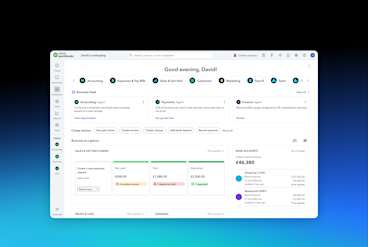
Cloud accounting
Automation vs AI vs Agentic: What every accountant should know
Simple, smart accounting software - no commitment, cancel anytime

GROWING YOUR BUSINESS
With careful planning, switching your accounting software can be a smooth process.
In this article, we’ll cover the key steps of how to change your accounting system, including choosing the right software for you, important milestones, and how to solve problems.
Your time is precious when you’re a small business; every penny counts. Before committing to switching accounting software, here are some essential things to consider.
Is your current accounting system no longer suitable? If it’s outdated, costly to update, or lacks the key features you need to grow, it may be worth investing in new software.
Make sure the reason you’re switching aligns with your long-term business goals. You might want to gain access to better tools like automation or forecasting. With technology, migrating your financial data is easier than ever, but it can still take time and planning.
Do the initial costs of switching accounting software outweigh the potential benefits? Upgrading usually involves a subscription fee, and it will take time to migrate your data.
However, these initial costs may be outweighed by long-term benefits, including:
Saving time through automating processes
Helping to reduce human error in data entry
Showing insights into your overall finances
Supporting your business’ long-term growth
If your current system is losing your business money or holding you back, it may be time to switch.
The size and complexity of your business should fit the accounting method you use.
Look for accounting software with features that support the unique needs of your business. If you travel a lot, look into mileage tracking. Or, if your business has a lot of employees, you could upgrade to an accounting system that incorporates payroll or HR features.
Consider how software could help your current operations, but also adapt for the future.
If your business is handling more transactions, users, or currencies, switching accounting software could help it to grow. A long-term solution is often better than a temporary one.
Some accounting software offers tiered pricing, allowing you to add features if needed.
Check your new accounting software integrates with your day-to-day systems.
For example, with Customer Relationship Management Systems (CRMs). Being able to link your software and apps together helps you save time on manual data entry.
If your business is moving to Making Tax Digital for Income Tax self-assessment, look for HMRC-compatible software.
Timing is crucial for a stress-free switch. If you’re planning to migrate, try a quiet period.
This could be the end of your financial year, or the winter period if your business is busiest in summer. Plan your timeline far enough in advance to ensure you have time to:
Provide training to your employees, so they understand the software
Organise, clean and migrate your data over to your new system
Test out the new system and run it in parallel with your old software
Investigate and fix any issues found during your testing stage
Protection against data breaches and cyber threats is vital for your business.
If you’re moving to an online system, look for features like encryption, secure cloud storage, and regular software updates. It’s worth researching their reviews and reputation.
With sensitive financial data and data regulations, security gives peace of mind.
If something goes wrong with your migration, or you’re unsure about how to use an unfamiliar feature, having a patient customer service team makes a big difference.
Some providers can support you through the whole setup and migration process.
Now we’ve covered what to consider before switching, we hope you feel more comfortable starting your search! If you feel confident to switch, here’s our step-by-step guide.
Switching accounting software is easier if you follow a clear, strategic approach.
Below, we break down the process into manageable stages. From choosing the right system for your business, to migrating your old data and testing for mismatches.
One-size-fits-all systems are rare, so it’s important to pick software that fits you.
Research software features and whether they’re needed for your business. It can help to ask some of the below questions when deciding which accounting software to commit to:
How complex is your business, and are you looking to grow?
Do you need software to integrate with payment tools or a CRM?
What is your monthly budget for a new software subscription?
How important is access to support from a customer service team?
What features would help you understand your finances better?
Are there any everyday processes that you’d prefer to automate?
How user-friendly and accessible does your software need to be?
If you’re not ready to settle, some providers offer a free trial, with no pressure to buy.
Ensure your new software works seamlessly with your essential day-to-day tools. This could be your CRM, manufacturing inventory, or payroll system for your employees.
Research how data will be transferred between these and your new software.
If your accounting software provider has a customer service team, they may be able to answer questions and help you get things up and running between your systems.
When planning the stages of your switch, here are some key dates for your diary.
Choosing the new system
Cleaning and organising data
Migrating data to the new system
Testing and troubleshooting
Onboarding your employees
Milestones are the foundation of good project planning and a smooth transition. Factor in more time than you think you’ll need, depending on the size and complexity of the data.
Ensure everything works before going live, ideally in a quieter business period.
Data migration can take a long time, but ensure you carry over the data you need.
HMRC may audit your records, so it’s important to go back as long as necessary. Key financial data may include client invoices, business income, payroll data, or expenses.
Archive any outdated or irrelevant data you don’t need, and clean the data you do.
Luckily, there’s software available to help speed up migrating your data to a new system.
However, this doesn’t mean you shouldn’t check your migrated data carefully. Rather than switching off your old software as soon as everything is swapped over, it’s wise to run both accounting systems in parallel to ensure the new one is working as you would expect.
Check the accuracy of key figures, such as balances, records and reports, to ensure everything is transferred correctly. Try testing the below scenarios to check for errors.
Do opening balances for accounts match the previous system?
Do reports (e.g. balance sheets) line up with historical data?
Does invoice creation and payment processing work properly?
Are payroll calculations and employee payment details correct?
Are customer and supplier records consistent with old data?
How long you run both systems in parallel will be up to your time and resources.
Thorough onboarding and training are essential for getting your whole team on board.
Whether it’s a readable guide, workshops, or training from the software provider, your employees will need a thorough introduction to your new accounting software.
Focus on key features related to their roles, for example, invoicing or reporting tools.
Switching software can be tricky, but preparation is your key to success. By understanding issues like data mismatches or onboarding hurdles, you can tackle them proactively.
If the formats or fields don’t match up between your old and new systems, data mismatches can occur. To reduce the chance of this happening, check and clean your data before you migrate it. You can also use tools to help shorten the checking process.
Not all data needs to be carried over to the new system. You may want to archive old data for tax purposes, and only transfer data you need for comparison or tracking trends.
Focus on essential records like active accounts and recent income and expenses.
If your team isn’t prepared, using new accounting software can be a challenge. By onboarding your employees, you’ll ensure the relevant people can use it confidently.
If you’re looking to switch accounting software effortlessly, QuickBooks can help.
Our range of simple, smart accounting software solutions can give you the tools you need to take your business to the next level. Here’s how we can make switching worthwhile:
Transfer your data easily, covering up to 2 years of historical data
Enjoy support every step of the way, whatever solution you’re switching from
Depending on the size of your site, transfers could take just a few hours
Plus expert product help from real people 7 days a week* and FREE 1 on 1 onboarding**. Save time, automate everyday tasks, and get a better picture of your finances today.
Learn how easy it is to switch to QuickBooks here, or try it for free today!
*Phone support available 8.00am - 7pm Monday - Friday or message them live 8.00am - 10.00pm Monday to Friday, 8.00am - 6.00pm Saturday & Sunday
**Onboarding session not available for the QuickBooks Sole Trader plan.
Switching accounting software can be difficult, but there are plenty of tools to streamline the process. If you choose a system like QuickBooks, we can help you migrate your data and walk you through the process, including testing and introducing you to features.
You should transfer old data across to the new system, but only what you need for comparison. QuickBooks can transfer the last two years of transactions over, helping see patterns in your spending. However, keep old data safe as HMRC may audit you.
The information on this website is provided free of charge and is intended to be helpful to a wide range of businesses. Because of its general nature the information cannot be taken as comprehensive and they do not constitute and should never be used as a substitute for legal, accounting, tax or professional advice. We cannot guarantee that the information applies to the individual circumstances of your business. Despite our best efforts it is possible that some information may be out of date. Any reliance you place on information found on this site or linked to on other websites will be at your own risk.
Subscribe to get our latest insights, promotions, and product releases straight to your inbox.
9.00am - 5.30pm Monday - Thursday
9.00am - 4.30pm Friday